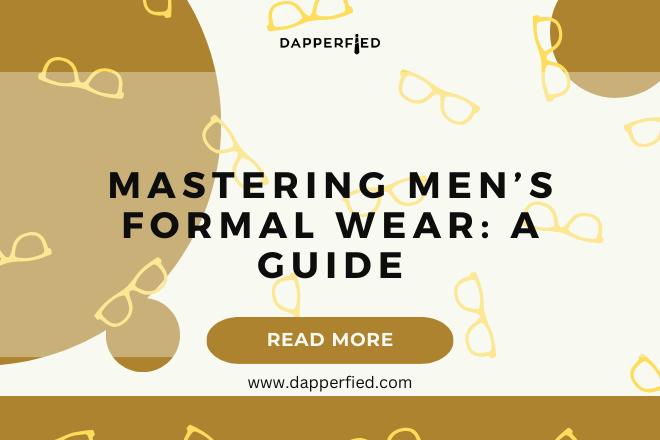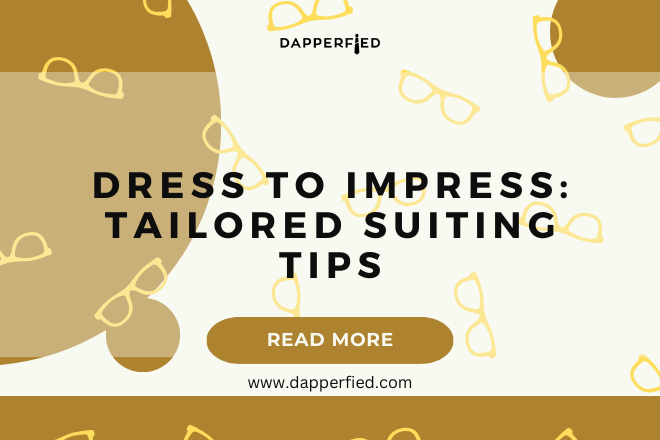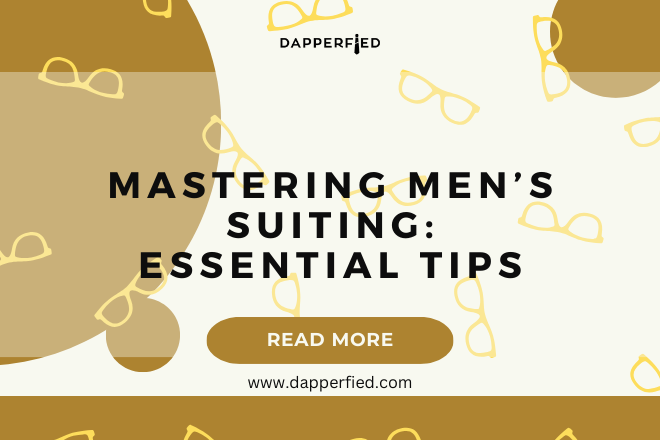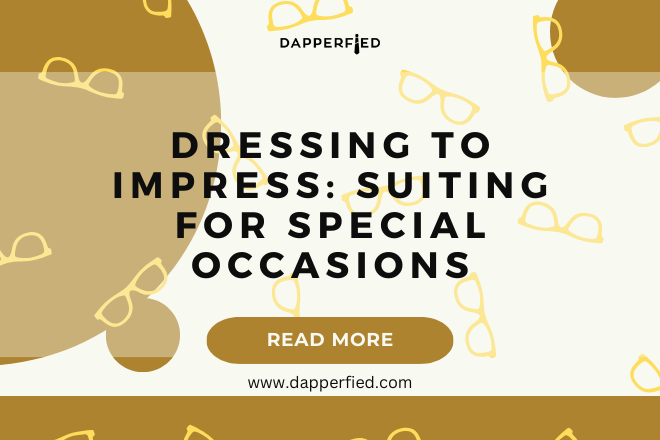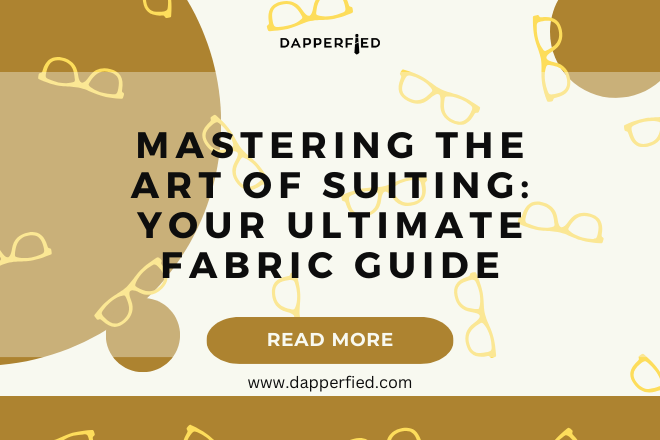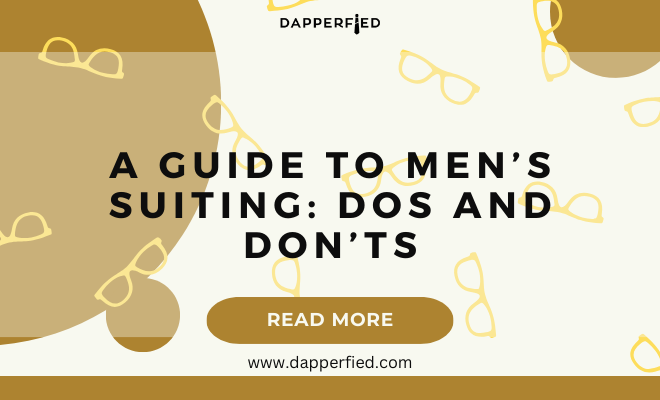
Men's Style
A Guide to Men’s Suiting: Dos and Don’ts
Men’s suiting has a long and rich history that dates back centuries. The suit, as we know it today, has evolved from its humble beginnings as a practical garment worn by men for work and formal occasions. Over time, it has become a symbol of style, sophistication, and professionalism.
A well-fitted suit is essential for any man’s wardrobe. It not only enhances your appearance but also boosts your confidence and makes a lasting impression. When it comes to suits, fit is everything. A poorly fitting suit can make you look sloppy and unprofessional, while a well-tailored suit can make you look sharp and put-together.
To avoid common mistakes when it comes to men’s suiting, there are a few key things to keep in mind. First, always opt for quality over quantity. Investing in a few high-quality suits that fit you well will always be better than having a closet full of ill-fitting, cheap suits. Second, pay attention to the details. Little things like the length of your pants or the width of your tie can make a big difference in how you look. Finally, don’t be afraid to experiment with different styles and colors. While classic navy and gray suits are timeless, there’s nothing wrong with adding a pop of color or trying out a more modern cut.
Key Takeaways
- Choose a suit that fits your body type to look your best
- Classic suits are timeless, modern suits are trendy, and trendy suits are daring
- Tailored suits offer the perfect fit and customization options
- Look for quality materials and construction when buying a suit
- Accessories can make or break a suit, so choose them wisely
Suit Selection Tips: How to Choose the Right Suit for Your Body Type
When it comes to choosing the right suit for your body type, it’s important to understand your body shape and what styles will flatter your figure the most. There are generally four main body types for men: slim, athletic, average, and larger.
For slim men, a slim-fit suit is the way to go. This style will accentuate your frame and create a sleek silhouette. Avoid boxy or oversized suits as they will make you look even slimmer. Athletic men with broader shoulders and a narrower waist can opt for a tailored or slim-fit suit to highlight their physique. Avoid suits that are too tight or too loose, as they will throw off your proportions.
Average body types have more flexibility when it comes to suit styles. A classic fit suit is a safe bet, as it will provide a comfortable and flattering fit. Avoid extremes like overly slim or baggy suits. For larger men, a regular or relaxed fit suit is the best choice. Look for suits with structured shoulders and a longer jacket length to create a balanced look. Avoid slim-fit suits or anything that is too tight, as it will only emphasize your size.
When it comes to finding the perfect fit, there are a few key things to keep in mind. First, the shoulder seams of the jacket should align with your natural shoulder line. If they are too wide or too narrow, the suit will not fit properly. Second, the jacket should button comfortably without pulling or gaping. If it does, it’s a sign that the jacket is either too small or too big. Finally, the pants should sit at your natural waistline and have a slight break at the bottom. Avoid pants that are too long or too short, as they will throw off the proportions of your suit.
Men’s Suiting Styles: Classic, Modern and Trendy
When it comes to men’s suiting styles, there are three main categories: classic, modern, and trendy. Each style has its own unique characteristics and can be worn for different occasions.
Classic suits are timeless and never go out of style. They are characterized by their clean lines, traditional cuts, and neutral colors like navy, gray, and black. Classic suits are versatile and can be worn for both formal and semi-formal occasions. They are a safe choice for any man’s wardrobe and can be easily dressed up or down with the right accessories.
Modern suits are a more contemporary take on traditional suiting. They often feature slimmer cuts, shorter jacket lengths, and narrower lapels. Modern suits come in a variety of colors and patterns, allowing for more personal expression. They are a great choice for younger men or those who want to add a modern twist to their wardrobe.
Trendy suits are all about making a statement. They often feature bold colors, unique patterns, and unconventional cuts. Trendy suits are best reserved for fashion-forward individuals or special occasions where you want to stand out. While they may not be as versatile as classic or modern suits, they can be a fun way to experiment with your style.
When choosing the right suit style for an occasion, it’s important to consider the dress code and the formality of the event. Classic suits are always a safe choice for formal events like weddings or business meetings. Modern suits can be worn for both formal and semi-formal occasions, depending on how they are styled. Trendy suits are best reserved for less formal events like parties or fashion-forward events.
Tailored Suit Guide: What to Expect from a Tailored Suit and How to Get the Perfect Fit
| Metrics | Description |
|---|---|
| Shoulder Width | The distance between the shoulder seams of the jacket |
| Chest Width | The distance across the chest of the jacket, measured under the arms |
| Waist Width | The narrowest part of the jacket, usually at the waist |
| Sleeve Length | The length of the sleeve from the shoulder seam to the cuff |
| Jacket Length | The length of the jacket from the collar to the hem |
| Pant Waist | The measurement around the waistband of the pants |
| Pant Inseam | The length of the pants from the crotch to the hem |
| Pant Outseam | The length of the pants from the waistband to the hem |
| Pant Rise | The distance from the crotch to the waistband of the pants |
A tailored suit is the epitome of men’s suiting. It is custom-made to your exact measurements and specifications, ensuring a perfect fit and impeccable craftsmanship. There are several benefits to investing in a tailored suit.
First and foremost, a tailored suit will fit you like a glove. It will enhance your body shape and highlight your best features. A well-fitted suit can make you look taller, slimmer, and more confident. It will also be more comfortable to wear, as it will be made specifically for your body.
During the tailoring process, you can expect several fittings to ensure that the suit is being made to your exact specifications. The tailor will take detailed measurements of your body and discuss your preferences for style, fabric, and details. They will then create a pattern and cut the fabric accordingly. After the initial fitting, there may be several adjustments made to ensure a perfect fit. This process can take several weeks or even months, depending on the complexity of the suit and the availability of the tailor.

To get the perfect fit for your tailored suit, there are a few things to keep in mind. First, be honest with your tailor about your body shape and any areas you would like to minimize or enhance. They are there to help you look your best and will be able to make recommendations based on your body type. Second, don’t be afraid to ask questions or voice any concerns you may have during the fitting process. The tailor is there to guide you and make sure you are happy with the final result. Finally, be patient. Tailoring takes time and precision, so it’s important to allow for enough time for the suit to be made and fitted properly.
Suit Buying Tips: What to Look for When Purchasing a Suit
When it comes to buying a suit off-the-rack, there are several factors to consider. First and foremost, pay attention to the fit. The suit should fit well in the shoulders, chest, and waist. It should not be too tight or too loose in any area. If necessary, take the suit to a tailor for minor adjustments to ensure a perfect fit.
In addition to fit, consider the fabric of the suit. Wool is a popular choice for suits as it is breathable, durable, and has a natural drape. Look for suits made from high-quality wool with a high thread count for added durability and comfort. Other popular fabric options include cotton, linen, and synthetic blends.
When it comes to color, navy and gray are classic choices that can be worn for any occasion. They are versatile and can be easily dressed up or down with the right accessories. Black is another popular choice for formal events, although it can be less versatile than navy or gray. If you’re feeling more adventurous, consider adding a pop of color to your wardrobe with a suit in a bold shade like burgundy or forest green.
When shopping on a budget, there are several ways to save money without sacrificing quality. First, consider shopping during sales or clearance events. Many retailers offer discounts on suits during certain times of the year. Second, consider buying separates instead of a full suit. This allows you to mix and match different pieces to create multiple outfits. Finally, consider buying second-hand or vintage suits. You can often find high-quality suits at a fraction of the price when shopping at thrift stores or online marketplaces.
Men’s Formal Wear: Tips for Dressing Up for Special Occasions

When it comes to dressing up for special occasions, it’s important to understand the dress code and dress accordingly. Formal events often have specific guidelines for attire, and it’s important to follow them to show respect for the occasion and the hosts.
For black-tie events, a tuxedo is the most appropriate choice. A traditional tuxedo consists of a black jacket with satin lapels, matching trousers with a satin stripe down the side, a white dress shirt, a black bow tie, and black patent leather shoes. Accessories like cufflinks and a pocket square can add a touch of personal style.
For white-tie events, the most formal dress code, a tailcoat is required. A tailcoat is a black jacket with long tails in the back, worn with matching trousers with a satin stripe down the side, a white wing-collar shirt, a white bow tie, and black patent leather shoes. This dress code is typically reserved for very formal events like state dinners or royal weddings.
For semi-formal events, such as weddings or cocktail parties, a dark suit is appropriate. Opt for a classic navy or gray suit and pair it with a crisp white dress shirt, a tie or bow tie, and leather dress shoes. Accessories like a pocket square or a tie clip can add a touch of personality to your outfit.

The Importance of Accessories: Shoes, Ties, Pocket Squares and More
Accessories play a crucial role in elevating a suit and adding personal style. They can make a simple suit look more polished and put-together. When choosing accessories, it’s important to consider the occasion, the color of your suit, and your personal style.
Shoes are one of the most important accessories when it comes to men’s suiting. They should be clean, polished, and in good condition. For formal events, opt for black leather dress shoes with a closed lacing system like oxfords or derbies. For less formal occasions, brown leather shoes or loafers can be a stylish choice.
Ties are another important accessory that can add color and personality to your outfit. When choosing a tie, consider the color and pattern of your suit. A solid-colored tie in a complementary shade is always a safe choice. If you’re feeling more adventurous, you can opt for a patterned tie like stripes or polka dots. Just make sure the pattern doesn’t clash with the pattern of your suit.
Pocket squares are a small but impactful accessory that can add a touch of elegance to your suit. They should complement the color of your suit and tie without being too matchy-matchy. A simple white pocket square is always a classic choice, but you can also experiment with different colors and patterns to add some flair to your outfit.
Other accessories like cufflinks, tie clips, and lapel pins can also add personality to your suit. Just make sure not to overdo it. Choose one or two accessories that complement each other and the overall look of your outfit.
Maintaining Your Suit: Cleaning and Storing Your Suit to Keep it Looking New
Properly cleaning and storing your suit is essential for maintaining its quality and ensuring it lasts for years to come. Here are some tips for keeping your suit looking new:
– Dry clean your suit sparingly. Dry cleaning can be harsh on the fabric and can cause it to lose its shape over time. Instead, spot clean any stains and only dry clean your suit when absolutely necessary.
– Hang your suit on a sturdy wooden or padded hanger. This will help maintain the shape of the jacket and prevent wrinkles. Avoid wire hangers, as they can cause the shoulders to lose their shape.
– Use a garment bag to protect your suit when traveling or storing it for long periods of time. This will prevent dust, moths, and other pests from damaging the fabric.
– Steam your suit to remove wrinkles instead of ironing it. Ironing can damage the fabric and leave shiny marks. Use a handheld steamer or hang your suit in the bathroom while you take a hot shower to release any wrinkles.
– Brush your suit regularly with a clothes brush to remove any dust or lint. This will keep the fabric looking fresh and prevent it from becoming dull or worn.
– Rotate your suits regularly to allow them to rest between wears. This will help them retain their shape and prevent excessive wear and tear.
By following these simple tips, you can keep your suit looking new and ensure it lasts for years to come.
Dressing for the Workplace: Professional Dress Codes and Etiquette
Dressing appropriately for the workplace is essential for projecting a professional image and showing respect for your job and colleagues. Different workplaces have different dress codes, so it’s important to understand what is expected of you.
In more formal workplaces, such as law firms or corporate offices, a business professional dress code is typically required. This means wearing a suit and tie for men. Opt for a classic navy or gray suit with a white or light blue dress shirt. Pair it with a conservative tie and leather dress shoes. Avoid loud patterns or bright colors, as they can be distracting in a professional setting.
In less formal workplaces, such as creative industries or startups, a business casual dress code may be more appropriate. This allows for more flexibility and personal style. You can opt for a blazer or sport coat with dress pants or chinos, paired with a button-down shirt or a sweater. Avoid jeans, t-shirts, and sneakers, as they are too casual for the workplace.
Regardless of the dress code, it’s important to dress professionally without sacrificing your personal style. Your appearance should reflect your professionalism and competence, while still allowing you to express your individuality. Pay attention to the fit and quality of your clothing, as well as the cleanliness and grooming of your overall appearance.
In addition to dressing appropriately, workplace etiquette is also important. Always be mindful of your behavior and how it may be perceived by others. Be respectful of your colleagues’ personal space and avoid wearing strong colognes or perfumes that may be overpowering. Dressing professionally and behaving respectfully will help you establish a positive reputation in the workplace and contribute to your overall success.
Dressing for Success: How Your Appearance Affects Your Confidence and Career
Your appearance plays a significant role in how you are perceived by others and how you feel about yourself. Dressing well can boost your confidence and make a positive impression on others, which can have a direct impact on your career success. When you dress professionally and put effort into your appearance, it shows that you take pride in yourself and your work. This can lead to increased respect from colleagues and superiors, as well as improved opportunities for advancement. Additionally, when you feel good about how you look, it can enhance your self-esteem and overall sense of self-worth. This confidence can translate into better performance at work, as you are more likely to take risks, speak up, and assert yourself in professional settings. Overall, dressing for success is not just about looking good; it is about projecting confidence and professionalism, which can have a significant impact on your career trajectory.
If you’re looking to up your suit game, it’s important to not only focus on the dos and don’ts of men’s suiting but also pay attention to the finer details. One crucial element that often gets overlooked is choosing the right belt. In this informative article on Dapperfied, you’ll find five essential tips for selecting the perfect men’s fashion belt. From understanding the different types of belts to matching them with your suit, this guide will ensure you make a stylish statement from head to toe. So, before you finalize your suit ensemble, be sure to check out this helpful resource: Men’s Fashion Belts: 5 Tips for Choosing the Right One.
FAQs
What are the dos and don’ts of men’s suiting?
The dos and don’ts of men’s suiting refer to the guidelines that men should follow when selecting and wearing suits.
What are some dos of men’s suiting?
Some dos of men’s suiting include selecting a suit that fits well, choosing a classic color and style, wearing a dress shirt that complements the suit, and accessorizing appropriately.
What are some don’ts of men’s suiting?
Some don’ts of men’s suiting include wearing a suit that is too tight or too loose, selecting a suit with a trendy or flashy design, wearing a dress shirt that clashes with the suit, and over-accessorizing.
Why is it important to follow the dos and don’ts of men’s suiting?
Following the dos and don’ts of men’s suiting can help men look professional, polished, and put-together. It can also help them make a good impression in professional and social settings.
What are some common mistakes men make when selecting and wearing suits?
Some common mistakes men make when selecting and wearing suits include choosing a suit that is too big or too small, wearing a suit that is outdated or inappropriate for the occasion, and failing to accessorize appropriately.
What should men consider when selecting a suit?
When selecting a suit, men should consider factors such as the fit, color, style, and occasion. They should also consider their body type and personal style preferences.




